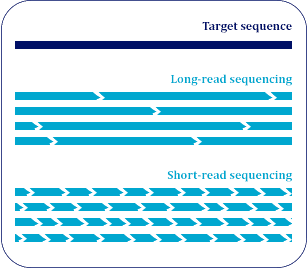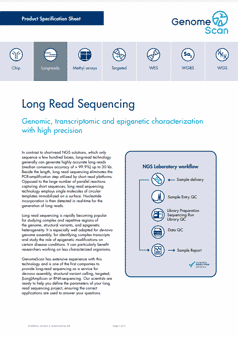Adeno-associated virus (AAV) Analysis:
Adeno-associated virus (AAV) vector is a non-enveloped single-stranded DNA virus used in gene therapy. Accurate validation, contamination detection, and quality control (QC) of recombinant AAV (rAAV) vectors are crucial to ensure the correct rAAV genomes are packaged into cells before therapeutic use, confirming the safety and efficacy of the therapy.
Advantages:
- Complete Characterization: Long nanopore sequencing reads can sequence full-length, native rAAV genomes end-to-end, allowing for the full characterization of inverted terminal repeats (ITRs). This helps identify truncated rAAV genomes, contamination, or mutations.
- Improved QC: Traditional short-read sequencing technology has limitations in mapping features like ITRs due to their high GC content, palindromic nature, and complex secondary structure. Long nanopore sequencing overcomes these limitations.
- Validation Support: Transgenes and promoters of interest can be identified, supporting the validation of rAAV vectors.
Whole Genome Sequencing (WGS):
Whole-genome sequencing aims to provide complete analysis of an organism’s genome (human, plant, animal, bacterial…)
Advantages:
- Easier assembly: Fewer fragments to assemble.
- Structural variant and repeat resolution: It can span entire structural variants and repeat segments in one read.
- Phasing: Enhance unambiguous allele phasing.
- Detection of base modifications: PCR-free nanopore sequencing enables the analysis of epigenetic modifications alongside nucleotide sequence from a single dataset.
- Cost-effective and scalable: A range of sequencing devices are available to suit all project sizes.
- Absence of GC bias: GC bias is virtually absent in native nanopore sequencing data, meaning greater uniformity of coverage compared to short-read assemblies
Targeted sequencing:
Is a valuable method of generating sufficient depth of coverage for regions of interest, for informative and cost-effective analysis. This can significantly reduce the number of sequencing libraries and runs required, and reduce the data analysis burden, for a quicker and more cost-efficient workflow.
Advantages:
- High-depth sequencing.
- Obtaining short or long sequences, depending on the length of the PCR.
- Possibility of multiplexing samples to reduce cost.
- If there is one or more regions or genes of interest, sequencing can be directed without manipulation of the DNA.
Epigenetics:
Epigenetics is crucial for regulating gene expression and is linked to various diseases, including cancer.
This approach is especially beneficial for detecting differentially methylated regions (DMRs), providing a comprehensive perspective on methylation patterns throughout extensive and intricate genomic areas.
Advantages:
- Detect base modifications alongside nucleotide sequence as standard with direct sequencing of native DNA and RNA.
- PCR-free.
- No additional sample preparation required.
Transcriptomics:
RNA transcripts are crucial for understanding gene expression, regulation and biological functions in various contexts, such as development, disease response, and adaptation to environmental changes. This service allows the analysis of different RNA isoforms, which is essential for understanding the complexity of gene regulation.
Advantages:
- Comprehensive Understanding of Gene Expression: Provides a detailed view of how genes are expressed and regulated under different conditions.
- Biomarker Identification: Helps identify biomarkers for diseases, which can improve diagnosis and treatment.
- Disease Research: Facilitates the study of molecular mechanisms underlying various diseases, including cancer and infectious diseases.












